Jan 26, 2010
http://www.openminds.tv/soviet-nukes-and-ufos/
It sounds like a tabloid headline, but the question is a valid one: Did UFOs almost trigger an accidental nuclear war in 1982? The incident in question occurred in south-central Ukraine on the evening of October 4th, according to official depositions from Soviet military units and interviews with one of the officers in charge of the investigation. There were multiple witnesses to the event, which took place between 7:30 and 9:37 pm, and many of them were Soviet military officers and personnel stationed at a long-range nuclear missile base in Usovo, near Byelokovoriche.
The depositions describe nighttime unidentified lights performing acrobatics in the sky over several villages around the missile base. That, in itself, is not particularly worrisome, as the reports don’t indicate any sign of hostility from the lights. But what happened at an underground bunker of Military Unit (MU) 52035, one which contained nuclear missiles launch control panels, is another matter entirely.

Retired Colonel Boris Sokolov (image credit: George Knapp).
“For a short time,” retired Air Force Colonel Boris Sokolov told ABC TV News Moscow correspondent David Ensor, “signal lights on both the control panels suddenly turned on, the lights showing that missiles were preparing for launching. This could normally only happen if an order was transmitted from Moscow.” As director of the Ministry of Defense’s effort for “research into the field of anomalous phenomena in the atmosphere and in outer space,” Sokolov became a member of the four-man commission set up to investigate the so-called Usovo case.
That was back in the early ‘80s when the missile targets were located in America, former KGB Director Yuri Andropov was General Secretary, and Ronald Reagan was denouncing the USSR as “the evil empire.” Today, of course, it’s a different story. The missile base was closed in the early 90s with the end of the cold war, the Ukraine is an independent country, and military witnesses are free to talk, sometimes. So we are lucky to have the official deposition of Major M. Davidovich Kataman, senior assistant of the commander of the Military Unit 52035’s communication service, in charge of the computerized control panels for the long-range nuclear missiles at the Usovo base. Major Kataman did not see the UFOs flying above because he was, at the time, on shift in the underground bunker. But what he did see was, militarily speaking, the stuff of nightmares in his line of work.
Major Kataman wrote in his deposition that, “on the 4th of October 1982 at 21:37, I observed spontaneous illumination of all displays: BR, P, Sh, DR, GP, SR, PR, CZ, BT, NBT, GP, message, GB message, PP, PS, OR, PNS, Z, PZG, PZNS, figure indicators as in the regime ‘light marks’ at first push on the information board.” Confusing as this sounds—and the difficulties of translation notwithstanding (1)—the Major is implying that someone or something was apparently manipulating the series of precise control codes, four spaces and control code combination, which regulate the computerized missile control launch panel. His deposition added that, “testing of apparatus and measurement of parameters according to technical map 1-30 showed no defects. The apparatus was functioning normally,” that is, before and after the strange “illumination of all displays.”
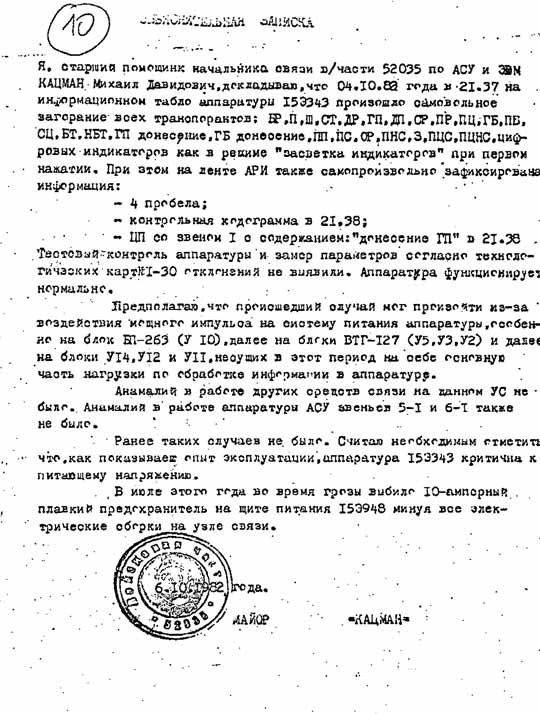
Major Kataman's deposition.
The officer then added: “I suppose that this effect can take place as a result of the influence of a powerful impulse on the apparatus’ power system, especially on block BP-263 (U-10) then on VTG-127 (U5, U3, U2) and then on blocks U14, U12 and U11 [missile silos], bearing the main load in processing data in the apparatus. No abnormal effects were observed in other communications means… No such cases had been observed before.” The equipment was later taken apart piece by piece but no anomalies or malfunctions were found.
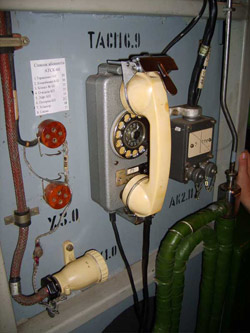
Museum of Strategic Missile Troops, near Pobuzke, Ukraine, http://www.eoghan.me.uk/tips/msmt/index.html
According to the ABC-TV News Prime Time Live segment “KGB UFO Files,” which was broadcast on October 6, 1994, “for 15 agonizing seconds, the base lost control of its nuclear weapons; what happened here on this day has never been explained.” ABC also interviewed two witnesses to the 1982 sighting: a civilian from Byelokovoriche and Lt. Col. Vladimir Platunov. Lt. Col. Platunov described the object as “… just like a flying saucer, the way they show them in the movies, no portholes, no nothing. The surface was absolutely even, the disc made a beautiful turn…on the edge, just like a plane. It [made] no sound. I had never seen anything like that before.”
In comparison, the language in the nine other depositions—in addition to Major Kataman’s—is quite sober. They are by witnesses from MU 52035 and MU 32157, and include one soldier, one Lieutenant, three Captains, two Majors and three Lt. Colonels. It’s quite an impressive list. The witnesses were in various locations, mostly on roads linking Byelokovoriche and the villages of Usovo, Topyilnja, Zhovtnevo, Perebrody and Korosten. These small villages probably will not appear in a general atlas, but the area is located in central Ukraine, south of the capital Kiev.
The Testimony
Captain Valery Polykhaev was on a bus, returning home from his post at the Usovo base at 7:30 pm on October 4, 1982. “After the bus stopped at the cross roads to Usovo,” he stated in his deposition, “I saw in the clear space above the road, at 5-6 km of altitude, two brightly shining objects resembling very much a New Year’s tree garland in it’s shape.” (I believe “New Year’s tree garland” is a politically correct, Communist term for a common Christmas tree decoration.) “They were shining with bright-golden light and those lights were twinkling,” continued Capt. Polykhaev. “There were 6-8 brightly shining spots making a circle in every object. The distance between objects was about 2-3 km. Then a shining small ball separated from the left object and moved to the right one.” The lights continued their acrobatics for another 5 to 7 minutes, according to the Captain, who added that, “while moving the object changed its shape, the twinkling lights reformed from an ellipsis to a straight line.”
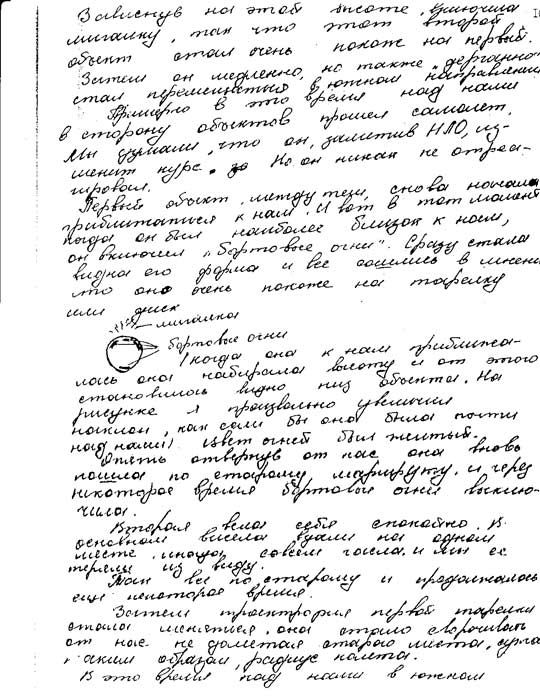
Hand written deposition with small sketch by one of the military witnesses of the Usovo case.
Lt. Colonel Balanev was returning home on the same military bus when, together with the rest of the passengers, he “observed a luminescence in the sky unknown to me from 19:20 to 19:40 hours. It was in the shape of many twinkling stars from pale-yellow to dark-cherry in color.” Other passengers in the bus who also witnessed the phenomenon and wrote depositions for the Ministry of Defense were Captains Duman and Tukmachev, and Lt. Colonels Povar and Kuzmin. Lt. Colonel Zinkovsky at first thought that it was a helicopter, but “on coming to the place where I observed the object, I saw that there was nothing there.”
Capt. Polykhaev saw the object again later in the evening. By 8 pm, he was driving his car with his wife, two children and some friends. They were near the railway crossing between Topyilnja station and Zhovtnevo street when they noticed once again an unusual light show in the skies over Usovo at an altitude of 5-7 km. “A bright light flashed and went out, then it flashed again and after that, 6-8 bright-golden lights flashed around it in the shape of an ellipsis,” continued Capt. Polykhaev’s deposition. “A small brightly shining ball separated from them and flew to the earth and on approaching it, went out. In 10 minutes the phenomenon repeated… the shining object began to move quickly in our side, with high speed and rising in size. Then the object suddenly stopped. Our distance to it was about 1-2 km. The children were scared that the object would fall down on us. After it stopped, the light went out slowly as if melted away. In ten minutes, another garland ‘flourished’ at a large distance and went out again.” Captain Kovalenko was in the same car with Capt. Polykhaev and basically described a similar event.
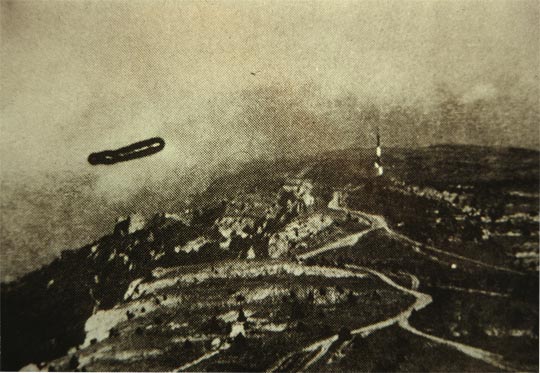
UFO photo taken in the Caucasus region, published in the Soviet Military Review.
Most of the depositions are shorter and less detailed than Capt. Polykhaev’s. Major Lipezki was driving along the Perebrody-Usovo road with Capt. Ryabinin. His deposition states that, “I paid attention to the luminescence of some object straight in front of me somewhere above Usovo. The luminescence came from a group of shining spots forming 5 groups. The lights were disposed on the area approximately equal to the area of the setting sun. It was situated at an altitude of about 30 meters above the edge of a distant forest. The color of the lights was from pale-yellow to red. It was about 19:10-19:15 hours.” The two officers saw the lights again twice as they continued on the road towards Byelokovoriche, which they reached without further excitement.
Senior Lieutenant Kobulyansky, the Battery vice-commander, and Major Drobakhin, also saw unidentified lights on and off from another car along the road to Byelokovoriche between 19:30 and 21 hours. At one point, they reported an apparent electromagnetic effect on the car radio, such as if “we were coming under high-voltage lines, but there were no high-voltage lines there,” states Lt. Kobulyansky’s deposition.
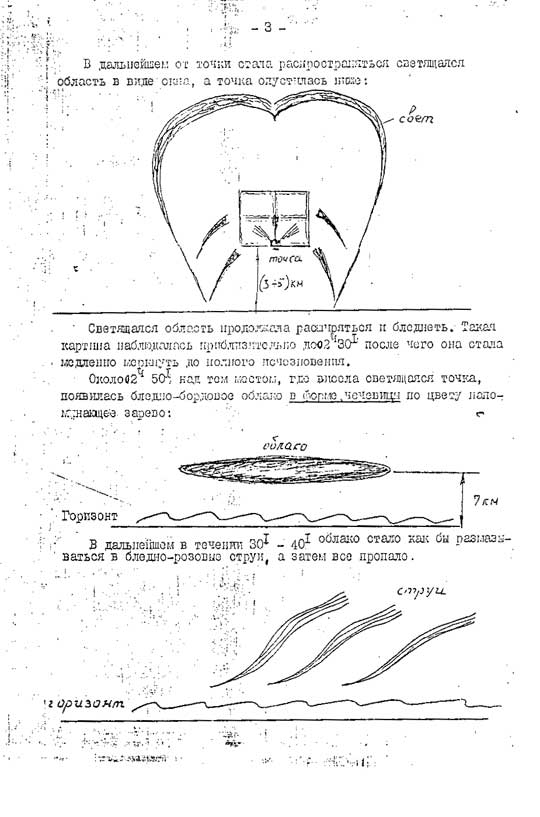
One of the military UFO documents from the dossier obtained by George Knapp.
No Conclusion
What could have triggered the multiple-witness UFO by several Soviet military officers in the Ukraine on October 4, 1982? The ABC broadcast added that “there were military exercises going on at the time of the incident involving explosives in the air, but they were over 200 miles away from here. The weather conditions were normal.” Unlike other Soviet military reports from Col. Sokolov’s collection we have obtained, the dossier on the Usovo affair is quite slim: nine pages with the typed depositions quoted above, but no evaluations, no technical appraisals on the control panel malfunction; no mention of other possible factors or data on military maneuvers, radar, additional witnesses, etc.; and perhaps most significantly, no conclusions by the investigating commission.
Presumably all or some of the additional data exists in a Russian Ministry or intelligence archive somewhere, but it’s still secret. Yet even if the incident’s visual component could be explained by flares and explosives from nearby military maneuvers—something Col. Sokolov has apparently discounted in his interviews—these could not account for the “spontaneous illumination” of the control panels reported by Major Kataman M. Davidovich, which makes this case unique.
The Soviet UFO Dossier
The report on the Usovo incident and other cases of “anomalous atmospheric phenomena” in the former Soviet Union would have remained secret under normal circumstances. However, the fall of communism and the demise of the USSR produced something that 15 or 20 years ago would have seemed unthinkable: the declassification and literal “sale” of government documents of all kinds—from nuclear disasters and sunken submarines to UFO reports and psychotronic research. George Knapp, the well-known reporter from KLAS-TV in Las Vegas, visited Moscow for the first time in 1993. With the assistance of Dr. Nikolai Kapranov, a national security advisor for the Russian Parliament, Knapp and his associate Bryan Gresh were able to meet and interview Boris Sokolov, the retired Soviet Air Force Colonel who directed the UFO collection effort for the Ministry of Defense between 1978 and 1988.
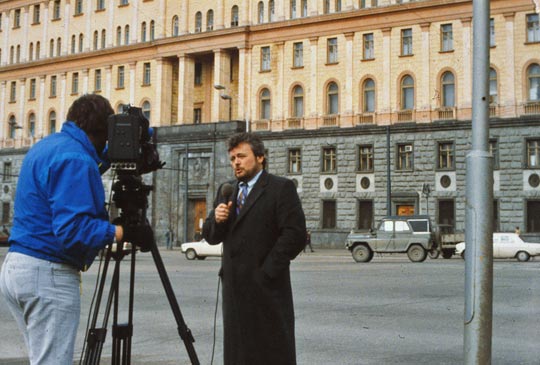
George Knapp in front of the old KGB headquarters during his trip to Moscow in the early 1990's (image credit: George Knapp)..
Col. Sokolov had kept copies of approximately 386 UFO sightings reported simultaneously to both the Ministry and the KGB and, after some delicate negotiations, the whole dossier was sold to George Knapp. “In essence,” says Knapp, “an order went off from the Ministry of Defense to every unit in the Soviet military empire to fully investigate, report on, and file any UFO sightings, so in essence the entire Soviet military was like a giant UFO listening post.” (2) The whole effort was undoubtedly cold war-oriented, as Col. Sokolov himself acknowledged in his interview with ABC: “It was presumed that if we obtained the knowledge of such technologies we would achieve a considerable advantage in the competition that we were unfortunately engaged at the time.”
The UFO documents obtained by Knapp can be divided in three broad categories. The first is a short Summary of 357 cases logged between 1978 and 1991. They give the date, time and location for each incident; a brief summary of the report; a notation on whether any space launches or other technical experiments took place on the same time; and finally what the investigators call “Influences,” such as radar detection, electromagnetic effect on equipment, or physiological effects on the witnesses. While these Summaries are basically raw or unevaluated data, some of them provide interesting and provocative reading.
The second part of Col. Sokolov’s dossier is a more detailed discussion of individual cases. These consist of full depositions written by the military witnesses, such as those reviewed in the Usovo case, as well as a complete Questionnaire. This questionnaire includes not just the obvious questions about time, shape, direction followed by the object, meteorological conditions, and so on, but also “Influence on technical means” (electric equipment, radar, etc.) and “Influence on people and other living beings and environment.” Drawings and sketches of the observation are also included in the Questionnaire.
The last category of documents obtained by Knapp are not part of the old Soviet Ministry archives kept by Col. Sokolov, but part of the “Thread-3” project undertaken since 1991 by the current Russian Ministry of Defense. These documents were actually smuggled out of Russia by Knapp, and their style and contents are quite different from the previous project. They consist of a number of reports not so much on individual UFO cases, but on a variety of topics such as: the history of UFO research in the USSR and Russia; propulsion and “non-traditional engines” and “the possible application for the creation of military and industrial technical devices”; a brief review of American UFO documents and popular Western ufological research; analysis of the messages and philosophical outlook of some Russian UFO contactees; reports and rumors of UFO sightings by Russian cosmonauts; and so on.
The head of “Thread-3” agreed to meet Knapp but only off-the-record; his name was not disclosed and his face hidden from the TV camera. But in 1992, a man described as “Lt. Colonel Alexander Platskin, a CIS-United Armed Forces consultant on the problem of anomalous phenomena,” was interviewed on camera on the record for the Russian documentary film, UFO: Top Secret, produced and directed by the Samara ufologist Dr. Vladimir Avinsky. Lt. Col. Platskin stated candidly that, “there were cases of unauthorized firing at UFOs from automatic weapons. For instance, in the Djerzhinsky region of the Gorky province, fighter planes rose to intercept UFOs and buried a glimpse more than once, but it was all in vain. The singularity of the phenomenon startled and terrified sentries who opened fire at the strange objects. Pilots often saw them on their radar screens.”
Col. Sokolov, in an interview with George Knapp, seemed to confirm Plastskin statement. “Pilots recognized UFOs as a threat to them,” he said. “There were 40 episodes in which they shot at UFOs. An order was given to pilots to chase UFOs and shoot at them, but when the pilots tried, the UFOs sped away… In three cases, the pilots lost control and crashed. Two of the pilots died. After that, pilots received a new order. When they see a UFO, change course and get out.”
Col. Sokolov’s Flip-Flop
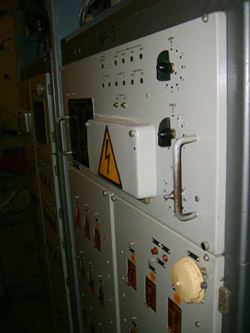
Museum of Strategic Missile Troops, near Pobuzke, Ukraine, http://www.eoghan.me.uk/tips/msmt/index.html.
In 2000, Col. Sokolov and Yuli Platov, a well known Russian scientist and UFO skeptic, published a comprehensive article in Vestnik Rossiiskoi Akademii Nauk, the official proceedings of the Russian Academy, titled “History of UFO State Research in the USSR.” It described the history of the secret military studies of UFOs between 1977 and 1990, only to dismiss the bulk of them as mostly space-related IFOs (Identified Flying Objects). “Practically all the mass night observations of ‘UFO’ were unambiguously identified as the effects accompanying the launches of the rockets or the tests of aerospace equipment,” stated the report. After discussing and debunking a few cases, Sokolov and Platov concluded that there were no genuine UFO landings, contact cases or abductions. “This means that either the territory of the USSR was, due to any reasons, closed for alien visitations during, at least, 13 years or that the hypothesis of an extraterrestrial origin of ‘UFO’ is inconsistent,” wrote Sokolov and Platov. You can access the entire Platov & Sokolov paper translated by James Oberg here [http://www.debunker.com/historical/HistoryRussianUFOlogy.html].
Needless to say, the Usovo case is also discussed in some length in the Russian Academy journal and debunked as well. The first strange item is that the authors give its date as October 5, 1983, while all the official depositions in our possession clearly state that the year was 1982. Could this be a typo either in the original or in the English translation supplied by the well known American space expert and UFO skeptic, James Oberg? Sokolov and Platov then explain the visual sightings in the Usovo area by bomb dropping exercises conducted at “an air polygon of the 26 army located in the belorussian Polesje approximately 400 kms from a place of observation.” Finally, the two authors deal with the nagging problem of the malfunction of the nuclear missile control panel described by Major Kataman. Nothing to worry about. Almost as an afterthought, they finished the section on the Usovo case with this statement: “It should be added, that the fault in the operation of the command post equipment had nothing to do with the observed phenomena, it just completely accidentally coincided in time. However, just this time coincidence was the main reason for an urgent investigation of the event.”
The main question we are left with is what happened to Col. Boris Sokolov. His article with Yuli Platov in 2000 sounds totally different to the man who was interviewed by George Knapp and ABC Prime Time Live in the early 1990s. What caused his reversal? One possibility is that he got some flack for giving Knapp the Soviet military UFO dossier. There is some murkiness on how this transaction took place and it’s almost certain that, given the dire economic situation in Russia at the time, Sokolov was paid for it.
Other UFO Incidents at Missile Bases
Another important point is that the Usovo case is not in a vacuum. There is at least a handful of incidents involving UFOs at sensitive installations with nuclear bases the in both the U.S. and the old USSR that are documented and there might be more in still secret military files. One fascinating case Soviet military case which ironically is not even mentioned in the Sokolov and Platov article, occurred at an army missile base in the district of Kapustin Yar, Astrakhan Region, on the night of July 28-29, 1989. A partial file of this incident was declassified by the KGB in 1991 to the late cosmonaut and general Pavel Popovich, as part of a so-called “blue folder” of 124 pages of “Cases of Observations of Anomalous Occurrences in the Territory of the USSR, 1982-1990.”
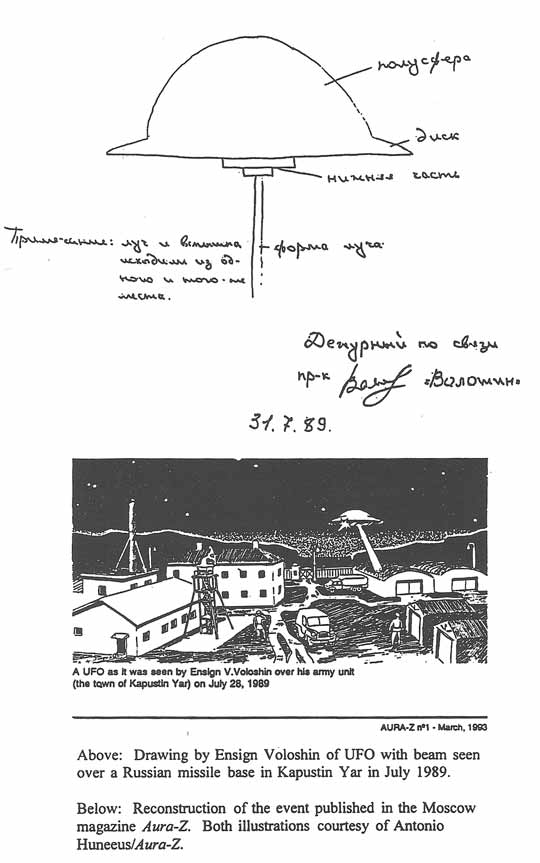
(image credit: UFO Briefing Document)
The Kapustin Yar dossier consists of the depositions of seven military witnesses (two junior officers, a corporal and four privates) plus illustrations of the object by the observers, and a brief case summary by an unnamed KGB officer. The KGB file is obviously incomplete, since there is no data on the jet scramble mission (which is mentioned) and no final conclusions. However, the documents we do have provide fascinating reading. The most detailed observation comes from the Officer-on-Duty, Ensign Valery N. Voloshin:
“One could clearly see a powerful blinking signal which resembled a camera flash in the night sky. The object flew over the unit’s logistics yard and moved in the direction of the rocket weapons depot, 300 meters [1,000 ft.] away. It hovered over the depot at a height of 20 meters [65 ft.]. The UFO’s hull shone with a dim green light which looked like phosphorous. It was a disc, 4 or 5 m. [13-17 ft.] in diameter, with a semispherical top.
“While the object was hovering over the depot, a bright beam appeared from the bottom of the disc, where the flash had been before, and made two or three circles, lighting the corner of one of the buildings… The movement of the beam lasted for several seconds, then the beam disappeared and the object, still flashing, moved in the direction of the railway station. After that, I observed the object hovering over the logistics yard, railway station and cement factory. Then it returned to the rocket weapons depot, and hovered over it at an altitude of 60-70 m. [200-240 ft.]. The object was observed from that time on, by the first guard-shift and its commander. At 1:30 hrs., the object flew in the direction of the city of Akhtubinsk and disappeared from sight. The flashes on the object were not periodical, I observed all this for exactly two hours: from 23:30 to 1:30.”
Ensign Voloshin also provided a sketch of the disc-shaped object emitting the beam (see picture). The multiple witness incident at Kapustin Yar was selected as one of the cases in the Laurance Rockefeller-funded UFO Briefing Document – The Best Available Evidence, which I coauthored with Don Berliner and Marie Galbraith in 1995. You can read our entire treatment of this episode here [http://www.bibliotecapleyades.net/ciencia/ufo_briefingdocument/1989.htm].
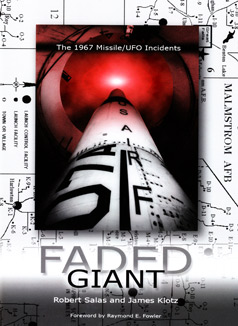
Faded Giant book cover
On the American side, there are at least two other similar examples of missile launch code manipulation coinciding with a UFO incident. The testimony of USAF Capt. (Ret.) Robert Salas, who was on duty at Oscar Flight as part of the 490th strategic missile squad in Malmstrom Air Force Base in Montana on the morning of March 16, 1967, is well known. Salas was one of the military witnesses at the famous Disclosure Project event in the National Press Club (NPC) in Washington, DC in May 2001; he later published in 2005, with James Klotz, the book Faded Giant – The 1967 Missile/UFO Incidents. Basically, Salas’ story is that on that fateful morning, while on duty inside the underground bunker, he received a call from the one of the guards, who sounded quite disturbed. “Sir, there’s a glowing red object hovering right outside the front gate – I’m looking at it right now. I’ve got all the men out here with their weapons drawn.” As Capt. Salas went to notify his superior of the situation, “our missiles starting shutting down one by one,” he testified at the NPC event. “By shutting down, I mean they went into a ‘no-go’ condition meaning they could not be launched.” You can read the full details in Faded Giant, which includes a large number of declassified documents.
Fast forward to the fall of 1975. This time the target was the K-7 Minuteman nuclear missile area at the Malmstrom Strategic Air Command (SAC) base in Montana, on November 7, 1975. It occurred during a famous two-week UFO flap at several SAC bases along the USA-Canada border. According to The UFO Cover-Up, the authoritative book by Lawrence Fawcett and Barry Greenwood on the declassified American UFO documents, “targeting teams, along with computer specialists, were brought to the [K-7] missile site to check out the missile, and specifically, the computer in the warhead that targets the missile. Amazingly, when the computer was checked, they found that the tape had mysteriously changed target numbers! The re-entry vehicle was then taken from the silo and brought back to the base. Eventually, the entire missile was changed.”
Although there are no specific declassified documents for this warhead computer tampering, the overall UFO flap over five SAC bases (Loring AFB, Maine, Wurtsmith AFB, Michigan, Malmstrom AFB, Montana, Minot AFB, North Dakota, and Canadian Forces Station Falconbridge, Ontario, Canada) during a two-week period in late October and early November 1975, is well known and fully documented by declassified USAF and NORAD documents. A couple of sample quotes provide the alert status of these incidents:
“Several recent sightings of unidentified aircraft/helicopters flying/hovering over Priority A restricted areas during the hours of darkness have prompted the implementation of security Option 3 at our northern tier bases. Since 27 Oct. 75, sightings have occurred at Loring AFB, Wurtsmith AFB, and most recently, at Malmstrom AFB. All attempts to identify these aircraft have met with negative results.” (CINCSAC Offutt AFB message, “Subject: Defense Against Helicopter Assault,” November 10, 1975.)
“November 7, Malmstrom AFB, Montana. A Sabotage Alert Team described seeing a brightly glowing orange, football field-sized disc that illuminated the Minuteman ICBM missile site. As F-106 jet interceptors approached, the UFO took off straight up, NORAD radar tracking it to an altitude of 200,000 feet [38 miles or 60 km.]. An object… emitted a light which illuminated the site driveway. The orange-gold object overhead also has small lights on it.” (24 NORAD Region Senior Director Log November 1975.)
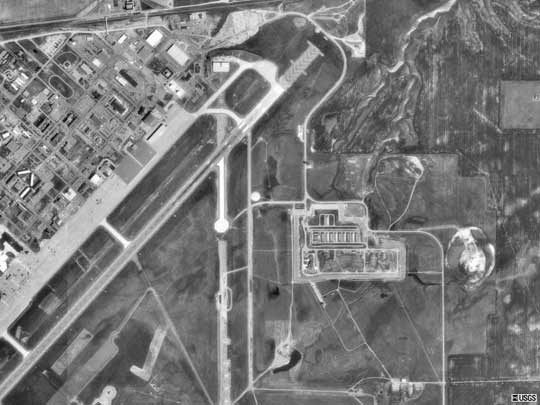
Malmstrom Air Force Base
With all these facts in mind, it’s not unreasonable to think that the nuclear superpowers set in motion a policy to deal with these situations and avoid a risk of nuclear war. A curious clause about “unidentified objects” within an Agreement on Measures to Reduce the Risk of Nuclear War between the United States of America and the Union of Soviet Socialists Republics, points in that direction. The Agreement was part of the policy of detente during the Nixon and early Brezhnev administrations. It was signed on September 30, 1971 by Secretary of State, William Rogers, and Foreign Minister, Andrei Gromyko.
The Agreement has nine articles on issues such as informing each other “against the accidental or unauthorized use of nuclear weapons under its control,” notification in advance of missile launches that go beyond the national territory of each country, and other measures of cooperation in order to avert “the risk of outbreak of nuclear war.” Article 3 reads: “The Parties undertake to notify each other immediately in the event of detection by missile warning systems of unidentified objects [emphasis added], or in the event of signs of interference with these systems or with related communications facilities, if such occurrences could create a risk of outbreak of nuclear war between the two countries.”
The interpretation of Article 3 as including the possibility of UFO incursions seems inescapable. It is indeed reassuring in view of the cases where UFOs hovered over military facilities with nuclear weapons (SAC bases in USA, NATO bases in England, missile bases in Russia). On the other hand, attorney Robert Bletchman pointed out that “unidentified objects” (UOs) include non-UFO situations as well (such as an accidental overflight by a civilian aircraft or a terrorist attack), but in the final analysis, UOs do include UFOs. What degree of cooperation about UOs/UFOs existed between the USA and USSR (and currently with Russia), is hard to say, but Article 9 stated: “This Agreement shall be of unlimited duration.”
Notes:
1. The depositions’ English translations were done in Russia and so the wording can be rough. I’ve edited the text slightly to make it more readable, but otherwise not changed the descriptions.
2. Knapp gave me copies of his entire Soviet and Russian military dossier in the fall of 1996, for publication originally in Japan (I was then a columnist for the now-defunct Tokyo paranormal magazine Borderland). An English version was also published in the journal The Anomalist Nº 7, Winter 1998/99.
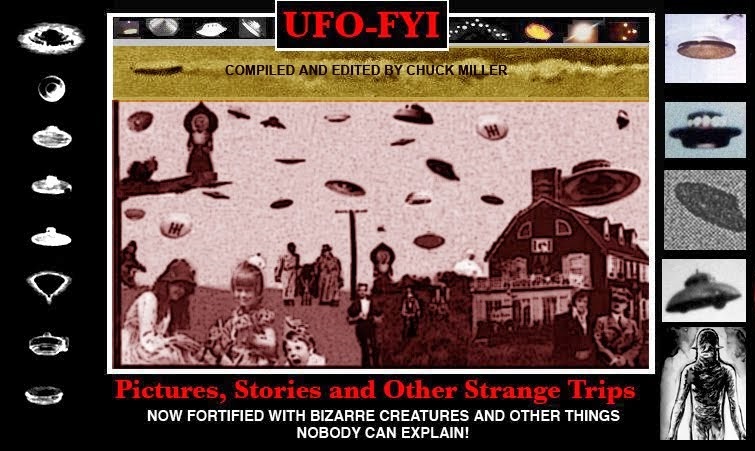
No comments:
Post a Comment
Note: Only a member of this blog may post a comment.